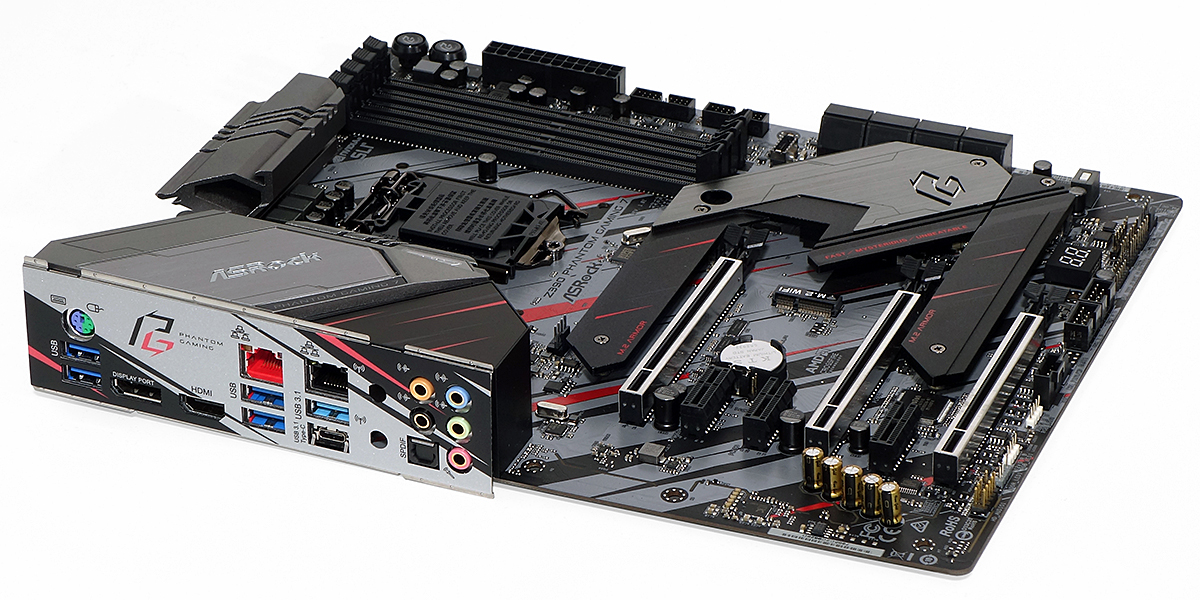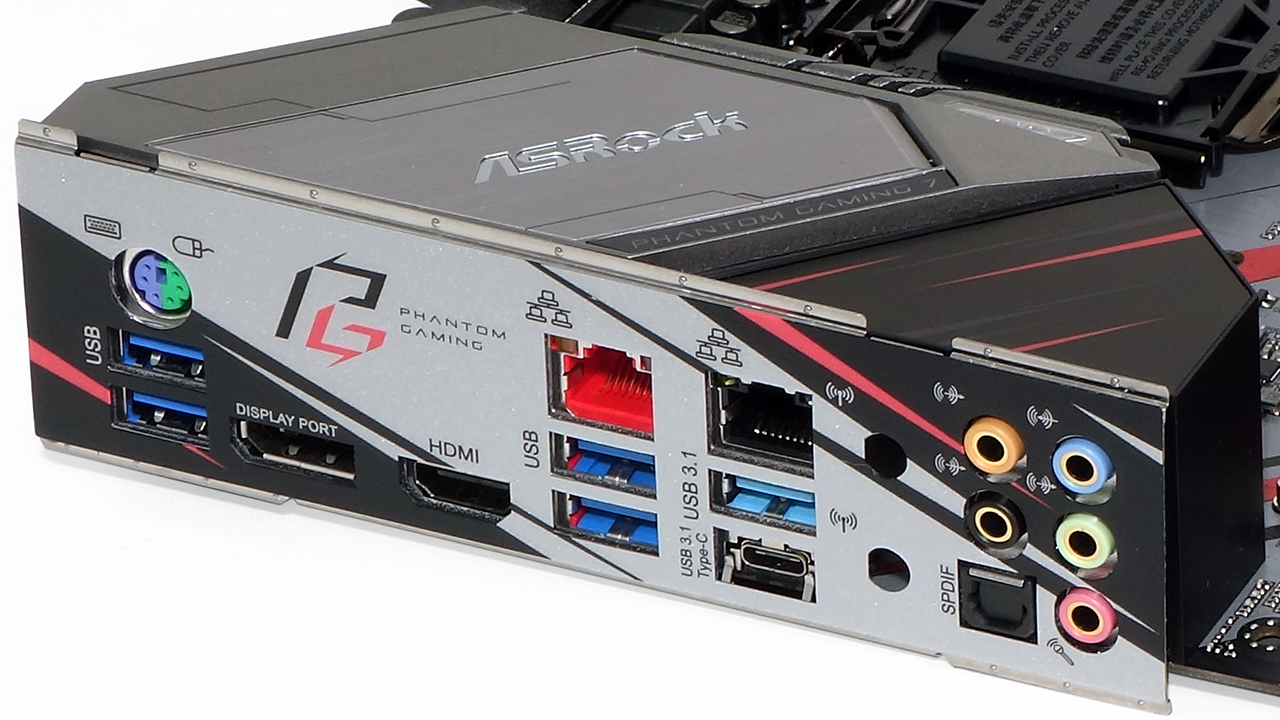Tom's Hardware Verdict
Builders prioritizing 2.5GbE and installing a Core i9-9900K should skip the Z390 Phantom Gaming 7 and step up to the Z390 Phantom Gaming 9. Those who don’t truly need 2.5GbE will find better in competing models.
Pros
- +
Motherboard-integrated 2.5GbE at a low price
- +
Advanced integrated RGB control
- +
Great DRAM overclocking
- +
Additional heat spreader for top M.2 slot
Cons
- -
Cumbersome M.2 SSD installation in top slot, due to heat spreader design
- -
Hot chokes require additional fan at stock Core i9-9900K frequency
- -
Mediocre performance and CPU overclocking
Why you can trust Tom's Hardware
Features and Layout
The $196 / £159 ASrock Z390 Phantom Gaming 7 fills the void between ASRock’s Z390 Phantom Gaming 9 (which we reviewed) and its Phantom Gaming 6 (which we didn’t), offering the more-expensive board’s 2.5 gigabit Ethernet controller but not its triple M.2 SSD support or Wi-Fi controller. The 7 costs about $25 less than the Phantom Gaming 9, but a more-thorough examination is required to find out if that lower price translates to a better value.
Specifications
| Socket | LGA 1151 |
| Chipset | Intel Z390 |
| Form Factor | ATX |
| Voltage Regulator | 10 Phases |
| Video Ports | DisplayPort 1.2, HDMI 1.4 |
| USB Ports | 10Gbps: (1) Type-C, (3) Type A5Gb/s: (4) Type A |
| Network Jacks | (1) 2.5GbE, (1) Gigabit Ethernet |
| Audio Jacks | (5) Analog, (1) Digital Out |
| Legacy Ports/Jacks | (1) PS/2 |
| Other Ports/Jack | Antenna Bracket |
| PCIe x16 | (3) v3.0 (x16/x0/x4, x8/x8/x4) |
| PCIe x8 | ✗ |
| PCIe x4 | ✗ |
| PCIe x1 | (3) v3.0 |
| CrossFire/SLI | 3x / 2x |
| DIMM slots | (4) DDR4 |
| M.2 slots | (2) PCIe 3.0 x4* / SATA*, (1) M.2 Key-E(*Consumes SATA Ports 0/1, 4/5) |
| U.2 Ports | ✗ |
| SATA Ports | (8) 6Gb/s (Ports 0/1, 3, 4/5 shared w/M.2) |
| USB Headers | (1) 5Gb/s Type-C, (2) v3.0, (2) v2.0 |
| Fan Headers | (5) 4-Pin |
| Legacy Interfaces | System (beep-code) Speaker |
| Other Interfaces | FP-Audio, ARGB, (2) RGB-LED, Thunderbolt AIC, TPM |
| Diagnostics Panel | Numeric |
| Internal Button/Switch | Power, Reset / ✗ |
| SATA Controllers | Integrated (0/1/5/10), ASM1061 PCIe |
| Ethernet Controllers | RTL8125AG PCIe, WGI219V PHY |
| Wi-Fi / Bluetooth | ✗ |
| USB Controllers | ASM1074 Hub |
| HD Audio Codec | ALC1220 |
| DDL/DTS Connect | ✗ / ✗ |
| Warranty | 3 Years |
The Z390 Phantom Gaming 7 might fill a gap in ASRock’s Phantom Gaming portfolio, but a quick overview of its headers shows remarkable similarities to the company’s Z390 Extreme4. An extra Ethernet port fed by Realtek’s 2.5GbE controller marks its major improvement over the non-Phantom-series board, though the Phantom Gaming 7 also adds a “Port 80” two-digit diagnostic display, onboard power and reset buttons, and a heat spreader for the upper M.2 drive slot. While users could purchase a separate Reatek 2.5GbE card for the Extreme4 for as little as $30, those lesser additions could make up the rest of the Phantom Gaming 7’s $40 price premium over its Extreme4 sibling.
Less obvious is the revised voltage regulator, which features fewer higher-capacity phases to address the power fiasco revealed in the Z390 Extreme4. Condemning the Extreme4 might not be the best way to promote the Phantom Gaming 7, but the new design gives us hope for expanded options in the sub-$200 enthusiast motherboard class.
Not every subtle design change is an improvement for builders, however. While the Z390 Extreme4’s upper PCIe x1 slot was above its top PCIe x16 slot, the Z390 Phantom Gaming 7 moves it below that slot. The coolers of most performance graphics cards require at least two slots of space, but such cards block card access to the Z390 Phantom Gaming 7’supper PCIe x1 slot.
Likewise, the additional heat spreader for the upper M.2 slot, while advertised as a benefit to end users, complicates SSD installation. That’s due to the heat spreader being integrated with the Z390 heatsink, which requires builders to remove the entire assembly to install the upper drive.
The second and third PCIe x1 slots are open-ended to enable the installation of cards with longer interfaces (such as x4), though doing this with the lower slot requires leaving off its M.2 head spreader. PCIe x16 slots are resourced as x16/x0/x4 or x8/x8/x4, with the top two slots sharing the CPU controller’s sixteen pathways and the lower slot competing with every other device (including M.2, USB and SATA) for bandwidth through the Z390 chipset’s 32Gb/s DMI.
The lower M.2 storage slot supports drives up to 110mm long, while the upper supports the common 80mm standard at most. In the center, an M.2 Key E slot supports both PCIe/USB and Intel CNVi module standards for notebook-style wireless cards.
Get Tom's Hardware's best news and in-depth reviews, straight to your inbox.
An extra SATA-based PCIe controller expands Z390 Phantom Gaming 7 legacy drive support, though the reason for this might not be immediately clear: Two SATA ports are disabled for each M.2 SSD a user installs.
A single second-generation front-panel USB 3.1 header resides above the SATA slots, but it’s limited to USB 3.0 transfer rates (5Gb/s). Though the data rate is only half of what the connector was designed to support, its inclusion allows users to connect the matching front-panel cable of their high-end case.
The Z390 Phantom Gaming 7’s bottom edge is filled with headers for front-panel audio, addressable RGB cables, two traditional RGB strips, a Thunderbolt upgrade card, two (of five) fans, two dual-port USB 2.0 front-panel cables, a trusted platform module, legacy (beep code) PC speaker and 3-pin power LED, and an Intel-style front-panel switch/LED set.
Similarities to the Z390 Extreme4 extend to the I/O panel, where placement is identical for the ports both boards have in common: The Z390 Phantom Gaming 7 loses the cheaper board’s VGA output and gains a second network port, with the single PS/2 keyboard/mouse, four USB 3.1 Gen1 (5Gb/s), DisplayPort 1.2 and HDMI 1.4 for onboard video, two USB 3.1 Gen2 (10Gb/s Type A and Type-C), five analog I/O and single digital audio ports remaining. Even the empty antenna holes are in the same location, though the Phantom Gaming 7 gets upgraded to a factory-installed (rather than snap-in) I/O panel shield.
The Z390 Phantom Gaming 7 includes four SATA cables, a legacy SLI bridge, M.2 mounting screws, a driver and application disc, a multi-language user manual, a software setup guide, a case badge, and a postcard. Currently in somewhat of a retro resurgence, postcards were the snail-mail predecessor of Instagram, where the picture promoting what you were doing was provided for you.
MORE: Best Motherboards
MORE: How To Choose A Motherboard
MORE: All Motherboard Content
-
g-unit1111 I really like this board and can't wait to see the review of the X570 version. The one trend that I do not like is the giant M2 covers, I feel like that could get really cumbersome in the long run. But this does look like a solid product.Reply -
B99RUO I'm not 100% sure but this one looks like yet another lie from mobo manufacturers. is this a proper 10 phase power board? With temps like that i seriously doubt it. It looks like the classic doubled components phases. This should be advertised as 4+2. That explains the poor O/C (that is a PRO feature) and the huge VRM temps (vrm cooling is another PRO feature). Led's are not a PRO feature. Apart from the post code .... and 100+ deg on the vrm will make that post code light up often enough ...Reply
I'm not 100% sure on the phases as i can't find a clear pcb pic anywhere but judging by the Phantom series of boards (all with crappy vrm, in no way PRO) and the huge temperatures it pulls, this is an entry level 4+2 phase board, good for a maximum of six cores and preferably no OC ...
It's place in ASrock's lineup suggest the same thing, average to entry level board masked up with LED's and 2 WIFI ants
No way is this a value proposition when for around 30-45USD more you can get the Z390 Taichi (not the ultimate) and that there is a proper board ...*as per pricing in my country -
Crashman Reply
Phase doubling wouldn't explain why the chokes were so hot, because those are on the other side of the MOSFETs.B99RUO said:I'm not 100% sure but this one looks like yet another lie from mobo manufacturers. is this a proper 10 phase power board? With temps like that i seriously doubt it. It looks like the classic doubled components phases. This should be advertised as 4+2. That explains the poor O/C (that is a PRO feature) and the huge VRM temps (vrm cooling is another PRO feature). Led's are not a PRO feature. Apart from the post code .... and 100+ deg on the vrm will make that post code light up often enough ...
I'm not 100% sure on the phases as i can't find a clear pcb pic anywhere but judging by the Phantom series of boards (all with crappy vrm, in no way PRO) and the huge temperatures it pulls, this is an entry level 4+2 phase board, good for a maximum of six cores and preferably no OC ...
It's place in ASrock's lineup suggest the same thing, average to entry level board masked up with LED's and 2 WIFI ants
No way is this a value proposition when for around 30-45USD more you can get the Z390 Taichi (not the ultimate) and that there is a proper board ...*as per pricing in my country






